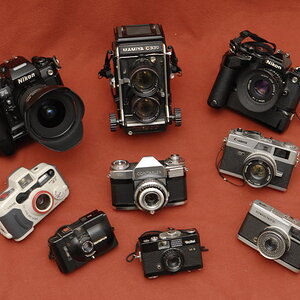RMThompson
the TPF moderators rock my world!
- Joined
- Nov 12, 2006
- Messages
- 1,888
- Reaction score
- 11
- Can others edit my Photos
- Photos NOT OK to edit
Check this blogpost out. Sounds interesting, but I sort of think of the flash as a good thing to create more dramatic lighting in some cases:
http://tech.yahoo.com/blogs/devlin/11619
Here is the text of the article:
http://tech.yahoo.com/blogs/devlin/11619
Here is the text of the article:
Imagine...no red eye. Period. Or no need for a flash on a digital camera.
Now that digital camera makers have come up with all kinds of ways to eliminate red eye and improve flash technology while stabilizing images, Kodak says it is developing digital technology that will nearly eliminate the need for a flash (and the oft-accompanying red eye) and improve performance in low-light conditions.
Here's how it would work: The new technology would increase light sensitivity of existing image sensors by two to four times. That means a camera's shutter speed could be cut in half, or at least a quarter, which would reduce camera shake and blurring problems. If it works, it also would allow photographers to shoot in low light without producing grainy, speckled photos.
The proof is in the pixels. In most digital cameras, each sensor pixel detects either the color red, green, or blue and places them into a pattern named for Bryce Bayer, the Kodak engineer who developed it. With the new high-sensitivity technology, half of the pixels will be panchromatic, or clear, so they will capture only the brightness, not color. That means a 12-megapixel camera would have 6 million panchromatic pixels, 3 million green pixels, 1.5 million red pixels, and 1.5 million blue pixels. In comparison, today's 12-megapixel cameras have 6 million green pixels, 3 million red, and 3 million.
The announcement is Kodak's latest big play in an intense bid to rebuild into a digital photography company as its film business dwindles. The company's plan is to make use of its proprietary intellectual property, including this image sensor technology, to compete in the crowded digicam market. Kodak entered the printer business this year with models that are slightly higher priced than competitors' but use ink that retails for about half the cost of other cartridges.
Kodak will build its own cameras with the new technology, but it also plans to sell it to other manufacturers since it works with existing image sensors. The new tech will be available in early 2008, but Kodak has given no word on when the first cameras with it fully built in will be on the market.
On each page in my photo albums of the kids since they were little, there's at least one photo besmirched by red eyes, the scourge of the snap shooter. More and more cameras are including tools to remove red eye in camera, while even the most amateur among us have become pretty adept at removing the demonizing glare with tools on photo software, online photo ordering sites, and in-store kiosks. But built-in technology that eliminates the need to tinker before and post shooting would be a welcome feature in a digital camera.
Is this the kind of feature you've been waiting for in a digital camera?







![[No title]](/data/xfmg/thumbnail/37/37494-d432dd0601f47668ec55d04f350f243b.jpg?1619738113)
![[No title]](/data/xfmg/thumbnail/31/31753-281132967af6a422c89bcc0d6f16499a.jpg?1619734991)



![[No title]](/data/xfmg/thumbnail/31/31751-fb2f68cca32f9eec468dbde7d649840f.jpg?1619734990)
